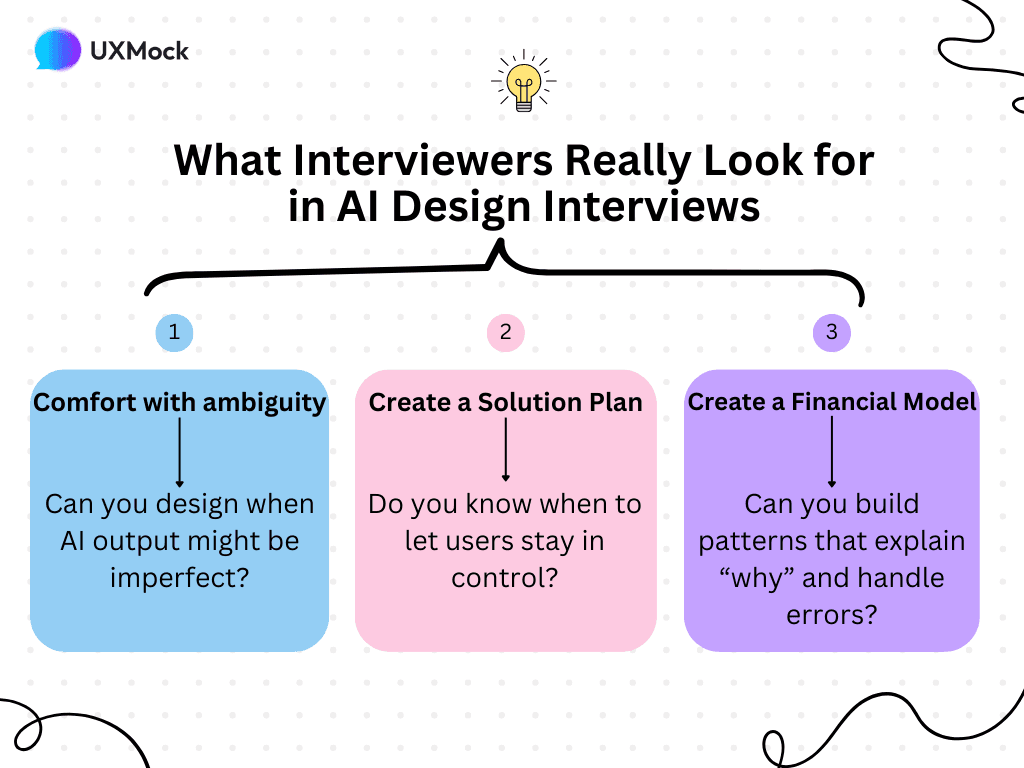Pro Tips
Aug 20, 2025

Introduction
If you’re a UI/UX or product designer preparing for interviews in 2025, you’ve probably noticed: every job post mentions AI.
But what if your past work doesn’t include AI tools or smart assistants?
👉 Good news: You don’t need to have shipped an AI product to land a top design role.
In this guide, you’ll learn how to:
Talk about AI in interviews (even without direct experience)
Create a portfolio project that demonstrates AI product thinking
Answer tough questions like “Do you have AI experience?” with confidence
Reframe your past work through an AI lens
Stand out in whiteboard and case study interviews
Let’s dive in 👇
What Interviewers Really Look for in AI Design Interviews

Even at companies building AI products, interviewers don’t expect you to be an AI engineer. What they want to see is:
Comfort with ambiguity → Can you design when AI output might be imperfect?
Human-AI handoff → Do you know when to let users stay in control?
Trust and transparency → Can you build patterns that explain “why” and handle errors?
💡 Example response you can use:
“If I added AI to this experience, I’d use it to auto-tag entries — but I’d also give users a chance to review and confirm for accuracy.”
This kind of answer shows AI product design thinking, even if you’ve never shipped an AI feature.
Build a Simple AI Concept Project for Your Portfolio
Don’t wait for your next job to “give you” AI experience. Instead, show initiative with a quick concept project.
Here’s a 3-step structure for building one:
Redesign an existing flow with AI
Example: Add a “smart summary” to a dashboard or “AI suggestions” to a task manager.
Use AI-specific UX patterns
Error handling, model confidence indicators, undo options.
Highlight trade-offs
“I’d automate tagging to save time, but keep a manual override to reduce mistakes.”
🧠 Pro Tip: You don’t need code. Figma + annotations explaining your decisions is enough to impress.
How to Answer: “Do You Have AI Experience?”
A strong response is honest, but forward-looking:
“Not in production yet — but I’ve explored AI UX through side projects, like designing an interface for summarizing feedback with LLMs. I’m especially interested in how we build trust and explainability.”
This answer signals: you’re actively learning, and ready to apply AI design skills in their context.
Reframe Your Past Work with an AI Lens
You don’t need to abandon your past projects. Instead, talk about how AI could enhance them.
“I redesigned a procurement dashboard last year. With AI, I’d add vendor suggestions based on historical pricing and usage.”
“In a reporting tool project, I’d add a smart assistant to auto-generate draft reports that users could then customize.”
This reframing shows you’re adaptable and future-oriented.
Practice with AI Whiteboard Prompts Using UXMock
AI questions are showing up more in whiteboard and case study interviews. To stay ahead, practice with realistic prompts.
At UXMock, we’ve built tools specifically for this:
✅ Industry-Based Prompts → AI scenarios in healthcare, fintech, productivity, and more
✅ Job Description Prompts → Paste a JD and get a custom interview challenge
✅ Custom Prompts → Enter your own and UXMock fills in missing context
👉 Perfect for UI/UX and product designers who want AI interview prep that matches today’s market.
Try it here: www.uxmock.io
Final Takeaway: You Don’t Need AI on Your Resume — Just in Your Thinking
To stand out in 2025 interviews, focus on showing that you:
Think in human-AI interaction flows
Design for trust, explainability, and control
Build small projects to demonstrate initiative
Reframe your past work with AI possibilities
Hiring managers don’t just want designers with experience — they want designers with vision.
Next time you’re in an interview, show them not just where you’ve been, but the kind of designer you’re becoming.
Want More Design Interview Prep?
Follow @UXMock on LinkedIn for design career tips
Read our AI UX whiteboard challenge guide
Try realistic AI interview scenarios at www.uxmock.io